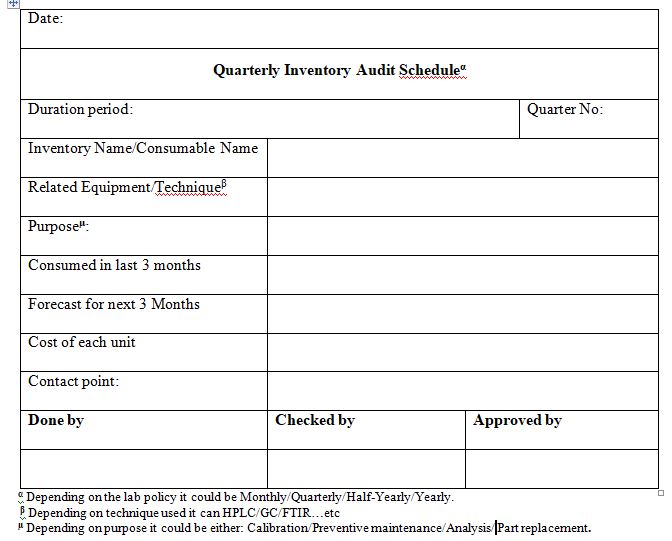Regardless of the size of your laboratory, inventory control is one of the most important things you can do to ensure a smooth operation. Keeping an eye on instruments, reagents, and consumables can be a challenging task. In this article we will discuss step by step approach for inventory management.
Here’s what you can do to make laboratory inventory management work for you:
Step-01: Create a Starting Point
- Inventory control is one of the most crucial things you can do to ensure a smooth operation, regardless of the size of your laboratory. It can be difficult to keep an eye on equipment, reagents, and consumables. Contrarily, efficiency will result in lower costs and higher output. Both production and laboratory inventory management systems share the same underlying idea: make sure there is enough stock.
Then note down:
- Spotting low-turnover stock: Your laboratory probably has some things on hand that you don’t need. Or perhaps you don’t need as many as you ordered.
- Demand forecasting – on the other hand, you can identify the goods you need more frequently by generating a list. Planning your stocks can help you forecast demand more accurately and order the appropriate quantity of goods.
- Sorting inventory items into classes: Sorting inventory items into classes can make your stock list even simpler to use. Your stock can be categorised using value, priorities, or kind. Reagents, consumable supplies, instrument spare parts, etc. are a few examples.
Step-02: Assess Stocking Levels and Reductions
- After you have completed making your list, consider what you might use more and less of. You should carefully consider every element of your daily schedule while you accomplish this.
- What goods are utilized most frequently? What number is used each week or each month? How many times have you placed new orders for these items in the last six months?
- Does your current project call for more stock than what is already there?
- Have you ever had to discard materials because they were past their best before date?
- Take a look at your greatest volume and highest cost items (based on what is being utilised), concentrating on only the top 10 or 20, and see if you can locate them in your stockrooms. As with the first step, focus on the 80/20 rule for your first pass.
- Okay, so your stock is now correctly listed. You can now assign minimum and maximum stock levels using it.
- The amount of shares you assign only serves as a guide as to how many assets you will require in the near future.
- Minimum stock level – this is the least amount of stock you need for your lab to operate. Determine the most extreme figure below which your team is unable to perform the task for each item on the list.
- Maximum stock level – this is the highest level of stock you need. It will guarantee that you have the appropriate number of resources to suit your lab’s needs without overstocking your stock.
- Working together with your team will help you determine the appropriate range of stock levels. Specifically, inquire as to what they typically use and in what amounts. Consider ordering time and keep constant watch of stock levels.
- Now it is time to put these findings to work. Make a fresh spreadsheet or list of all the products you intend to keep using. Keep in mind the very minimum that your lab will stock. This will serve as the cutoff point for reordering. The predetermined time to place a new order would be when the supply has fallen below this cutoff point.
Step-03: Organize your workspace
After you organize your stock list, the next step is to do this accordingly with your workspace.
- Start by storing your assets in the lab strategically. While active objects remain at eye level, think about storing less-often-used goods on higher shelves. You can also arrange laboratory chemicals alphabetically.
- Next, appropriately label your assets. To make it simpler for everyone to look for stuff, this step is essential. Samples, shelves, and cabinets should be labelled using a consistent manner.
- Keep everything tidy and out of the way, and then. Your workspace shouldn’t have any unused tools or supplies, such as glasses or notebooks. Your space will be organised, improving overall productivity and safety.
Step-04: Assign Team Duties
- To make the entire process more achievable, it would be a great idea to assign team members individual responsibilities. Consider giving one lab worker the responsibility of stocking new orders and another the job of inventorying stock levels. It’s possible to delegate responsibility for equipment service schedules to other team members. One of the most effective strategies to guarantee that your lab inventory management system functions perfectly is to get everyone on the same page.
Step-05: Maintain Records for lab inventory
- Lab supplies are not the only thing you should be keeping close track of. Running a successful lab depends on keeping accurate records and maintaining safe storage. Receipts are a useful tool for remembering product numbers and suppliers you bought from in addition to keeping track of costs. Additionally, hard copies must be retained. Important documents can be well-protected with fire-resistant file cabinets.
